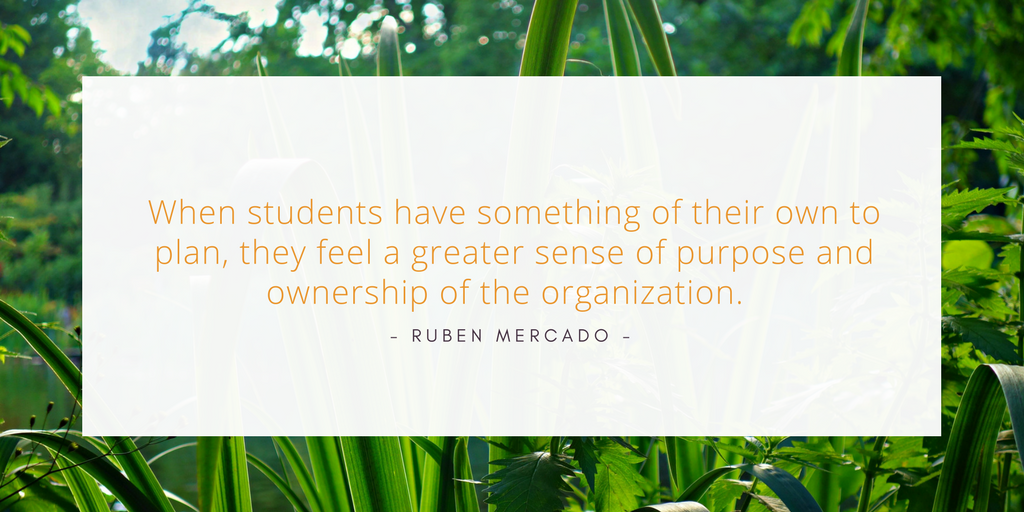On-campus involvement can be a very rewarding experience for college students.
Astin’s Theory of Student Involvement (1984) states that a student’s involvement in college directly impacts the amount of student learning and personal development.
As a new semester approaches, a new opportunity arises to recruit members for the student organizations you work with. Recruiting can seem simple, and we often rely on the same tried and true methods like tabling, social media, and word of mouth.
However, keeping students involved is far more difficult than the initial recruitment process for a variety of reasons.
The first few weeks of the semester serve as a test period for students; they’re seeing what they want to get involved in and how much they can manage. Students may attend several meetings at the start of the semester with a variety of organizations, and may just be seeing which ones they like the most and can devote time to.
As the semester starts to go on, students can face more challenges that would prevent them from being as involved as they would like to be: an increased rigor in their courses, having to work, personal or family issues, or interest in other hobbies.
With this in mind, here are some tips to help retain students and make your organization more appealing to those who may be visiting:
Creating a welcoming environment
This may seem simple, but if you work with a large organization, it can be easy for a new attendee or member to blend into the crowd and not feel welcomed as a result. Work with your students to identify any newcomers to your organization and make them feel welcomed. Learn their name and pronouns, introduce them to others, and make sure they have opportunities to provide input.
When a student walks into a meeting or event for the first time, you or one of your student leaders should make it a point to introduce yourself and greet them so they can start making a connection. If a student is walking into a meeting of an organization where they don’t already know someone, meeting someone within the first few seconds of being there can be a huge relief and be a very memorable experience for that student. This effort shows the student that they are valued and a welcome inclusion in the group.
When starting a meeting, icebreakers are also a good way to get people comfortable and talking to each other. Although some students may be hesitant or think the game may be a little silly, when done right, they can be a unifying experience and give them something to talk about with other members. Some icebreakers that are effective in large and small groups include Name Aerobics, Two Truths and a Lie, the Beach Ball Game, and Getting to Know You BINGO.
Utilize small groups
This is particularly beneficial of you are working with a large student organization that has more than 15-20 members. If your organization is already on the smaller side, that’s ok! Even better! This may make it easier for the other strategies discussed in this post.
When working with a large group, finding a way to make the groups smaller can be very beneficial. This can take place in the form of breakout sessions during meetings or small group activities and icebreakers. Students who may be nervous about speaking in large groups may feel more comfortable in small groups. These smaller numbers may make it easier to make lasting connections with students and make them more willing to come back.
Have some of the leaders in your organization lead the small groups in discussion about a recent event or future event the organization may be planning. Groups of about 5-6 are ideal and encourage everyone taking part to speak up and contribute. Making the group into more manageable sizes can help the students feel as though they have a sense of ownership and are more invested, which can help your organization stand out from others that they may be thinking of joining.
Follow up
Your organization should be keeping track of attendance and potential membership some way.
If your institution has a particular program they use, make sure leaders are well-trained in how to maintain this data and keep track of it. If something is not already in place, make sure that you establish some method of keeping track of information — this will help keep students from slipping through the cracks.
However your organization tracks attendance, be sure to utilize that data to keep in touch with new members and attendees. For a student who may be on the fence about whether they want to get involved or not, some personalized outreach could make a big difference to their decision. Making sure students feel valued is an important part of retention.
In a large setting where students may be struggling to make connections, students may not be receiving much personalized follow up. Students can feel like just a number in their large classes, residence halls, and organizations. Feeling lost like this can be a contributing factor to students leaving the institution entirely. Doing personalized, individual follow-up can make the student feel less like a number and more like a valued member of a community.
Reaching out about their involvement can also lead to larger conversations about how their college experience is going and help intervene and connect them to campus resources. It’s important to remember that our interactions with students are just part of a larger picture, and knowing the whole story can be a phone call to a colleague away.
Develop buy-in
Identify your organization’s mission and vision statements, and make sure everyone involved knows them and buys into them. When your members and leaders know these and can comfortably explain them, it is easier to get new members involved and bought into the mission.
When students are trying out new organizations, they want to know what the organization is about and what makes it different from other groups they may be considering.
Once you have identified and made clear to students what the organization’s mission is, find a way for them to get directly involved and give back. When students are seeking out new organizations to join, they don’t want to just sit through meetings. Identify an icebreaker that new students may be able to plan. If your organization regularly does events or social get-togethers, see if any new members would like the opportunity to be involved in the planning process.
When students have something of their own to plan, they feel a greater sense of purpose and ownership of the organization.

Remember that on-campus involvement can be a major part of a student’s life and college experience. Once we have recruited new members and the semester is starting off, be intentional about how to keep those students involved and coming back.
Following these strategies can help students feel more welcome and engaged not just in your organization, but the university as a whole.
How do you keep your student members involved?






